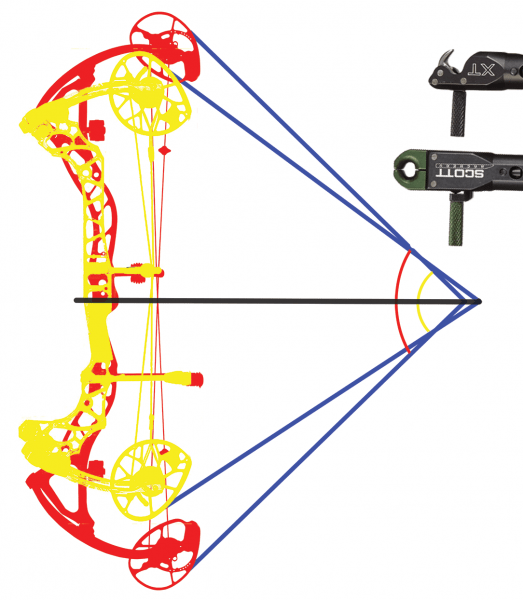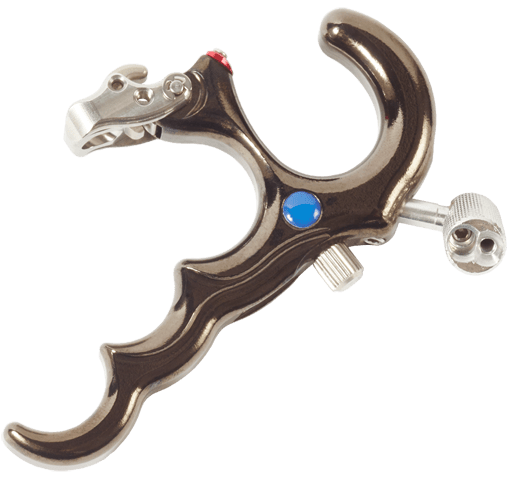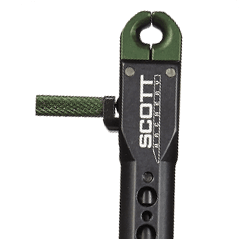
Almost everybody I know started their archery life with a cheapish, if not the cheapest release they could get away with. The strange thing is that making an informed decision about your release choice will almost always have an effect on your grouping and ability to consistently provide accurate shots at different angles.
I don’t believe there is a “best” release… I DO, however, believe there is a “best release for you”!
So lets have a quick look at the releases and why they exist, and then you, as a new bowhunter, can make a slightly more educated choice if you can’t shoot a few before you actually spend money on one.
There are two main schools for how you release, one is called a “command” technique (the shooter makes the full decision of when a shot is going to break), and the other is called a “back tension” technique (the archer has a time window in which the shot breaks as a surprise)
Now, without going into too much detail, I think a basic explanation about the techniques (or the thought behind them) is in order.
The Command Shooter literally decides to take the shot. The archer lines up the shot, and pulls the trigger or releases the arrow. It seems simple enough, but the really big disadvantage is that if you are new, and still struggle a bit with form, it is super easy to become an archery gangster (a drive by shooter)
Instead of holding on the target, the archer will anticipate the shot as it floats over the X. If he/she are quick, they will be off on one side, if they are slow, they will be off on the other side. Do this often enough, and your front hand (bow hand) starts to react as you anticipate the release, flicking the bow up, or dropping out of the shot (giving you high and low shots.
If no-one helps you at this point, it’s extremely easy to develop full blown target panic.
 The Back Tension Shooter uses a technique where you line up the shot on target, and then slowly increase pressure on the trigger until it disengages and the arrow releases. Now, the tension can be applied with the back muscles (typically the Rhomboids) but some shoot with their deltoids and some simply applies a slow pressure with their fingers.
The Back Tension Shooter uses a technique where you line up the shot on target, and then slowly increase pressure on the trigger until it disengages and the arrow releases. Now, the tension can be applied with the back muscles (typically the Rhomboids) but some shoot with their deltoids and some simply applies a slow pressure with their fingers.
The actual technique takes a while to perfect, but the idea remains the same:
Start the action to release the arrow very slowly, the action keeps going, and you shift your focus to aiming the bow instead of releasing the arrow. The arrow generally goes of within a few seconds in any case.
Two big benefits of this type of technique is that the added pressure (as little as it may be) keeps on reinforcing the structure of a drawn bow, creating stability – a steady aim – and shifting the focus to the target instead of the release, means you will have a harder time anticipating the release, flinching or dropping out of the shot.
Release Necks…?!

There really are a lot of variations on releases, and a lot of them will simply be personal preferences, but the length of the release neck is often overlooked.
The Neck of the release is essentially the distance from the trigger mechanism to the inside of the calipers (on a wrist style release), or the distance from the inside of the calipers to the inside of the grip (on a hinge or thumb release)
When will this choice have an impact? On short Axle-to-Axle bows, like the Mathews Triax, the string angle is very sharp at the D-loop. A short neck allows the string to be longer, and make a consistent anchor possible with a straight back elbow.
With a longer Axle-to-Axle (ATA) bow, like a Bowtech BT-Mag, the string angle is a lot shallower and a longer neck helps with a consistent anchor.
Is this some kind of a rule? Absolutely not! It just makes one part of learning consistent archery technique a little easier.
On to the release types… The three types of release you will most probably be offered is a wrist release, a thumb release or a hinge release.
 The most likely is the Wrist Release.
The most likely is the Wrist Release.
This style of release is generally a strap that fastens with a buckle or velcro around your wrist, hooks onto your D-loop and has a trigger like on a gun that you pull on with your index finger to open the calipers and release the string.
It’s simple and straight forward and easy to operate (and most people associate the shooting of a rifle with the technique. It’s simple because its something they know.
Typically you will find these in one of three configurations and almost every brand has a variation on this main idea:
Single Caliper
This type of release opens only on one side, which means the release can be pushed closer to your face (less angle/torque on the release itself). It also means that the release can often be set to let go at a much lighter touch. Lastly, it has very few moving parts, so it’s considered to be very reliable.
Dual Caliper (Double Caliper)
This is a system that symmetrically releases two calipers at the same time, allowing for an even distribution of tension and friction on the D-Loop. What that means is that the d-loop slides off the calipers quicker and with less movement or friction, and is considered a “clean release” head (the calipers move out of the way on both sides and the string leaves from the middle)
Dual calipers are often more adjustable on tension settings, so if you like a heavier trigger mechanism (harder pull on the trigger before it releases) one of these types might be closer to what you are looking for
String loop or Hook Releases
This type of release allows you to hook on the release from the side, and once released, swivels completely out of the way of the string/D-loop. It’s probably the most complicated mechanism, but this in turn also means it’s often the most adjustable on tension.
These also tend to be very short necked releases, simply because a shorter control arm means a stronger control arm. The benefit obviously comes in with the short ATA bows.
Why use a wrist release?
As mentioned, many people easily get the idea of a trigger like a rifle or gun. but another great advantage is that you do not need any hand strength to draw a bow. Any injury or arthritis in the fingers has no effect on the ability to shoot this style of release.
Are you shooting in extreme weather? Gloves are easily manageable as well (REMEMBER TO PRACTICE IN GLOVES IF YOU ARE GOING TO HUNT IN GLOVES!)
It is also difficult to pull a wrist release off target if your back arm (release arm) is straight in line with the arrow… There are a bunch of benefits… the least of which is possibly that when you are done, strap the release to your bow… you will never arrive in a hide or in a tree stand with your release at home or in your vehicle!
The main complaint with this style of release is that people tend to shoot it in a command style, which often leads to mild (or severe) target panic. Its often referred to as a “slap strap” because its so easy to “slap” the trigger like a little hamster wiping his mouth!
On some people they also struggle to get anchor consistency as they release can move around on the arm. Another “negative” is that the wrist release is the original bowhunter’s fidget spinner! Hunters can’t stop playing with the release while waiting for animals to come in, making noise and more movement than necessary… it sounds absurd, but you will remember this one day!
What to look for: Adjustability.
Start by matching the neck with your Axle-To-Axle (there is no formula, simply take a short neck for short ATA bows, medium for most hunting bows, and long for the Longer ATA bows – if in doubt, go medium)
Now pick the one that is most adjustable, because especially at the beginning, you will not be sure if you have the patience to hang on your release (heavy trigger) or need the lightest touch. Matching equipment to you is always more preferable to doing it the other way round.
 Thumb Releases or Thumb Triggers is the next option you will see a lot of. They are a bit more complicated and a bit more expensive than a wrist release, but many archers “upgrade” to a thumb release.
Thumb Releases or Thumb Triggers is the next option you will see a lot of. They are a bit more complicated and a bit more expensive than a wrist release, but many archers “upgrade” to a thumb release.
I have noticed that too many archers think they shoot better with a thumb release because it’s a thumb release. Meanwhile, it’s simply a matter of starting with a mismatched or cheap wrist release, and now going over to something that better matches your form and draw length.
That said, I like the thumb release for hunting because it allows you to use a dumber finger to trigger the release action.
Your thumb is a slower moving digit, so everything seems to slow down a bit. Also, I have found that slapping a thumb release will probably give you really wild results, so there is a definite feedback that your form or technique is lacking.
Another advantage is that if you are shooting at extreme angles or from odd or cramped positions where full extension is difficult, a thumb release seems to be easier to keep in alignment than both a wrist or hinge release.
The negatives, are all manageable, but you need to pay attention. Like always, if you are going to shoot in gloves, practice in gloves, but then also make sure that the grip space is enough to accommodate a glove! The second one catches out a few people… The thumb release mechanism sits close to your neck. Your cold weather jackets, camo or ghille suit is in a perfect position to snag on the thumb triggering arm, either catching it, stopping the arrow from releasing, or putting pressure on it, releasing the calipers and arrow prematurely… neither is a good answer!
PRACTICE IN THE CLOTHING YOU WILL BE HUNTING IN!
What to look for: Comfort
As you will physically be drawing the bow with your hands and fingers, look for a release that will distribute the pressure evenly over all the fingers in your hand. As we mentioned pick a release that will fit your gloves (if needed) but also be comfortable if you don’t shoot in gloves.
The same guidelines apply for neck lengths but you are much more likely to see single caliper or hook style options instead of dual calipers on the actual release mechanism. Depending on how you anchor, a rotating head might be a a great idea, it simply means the calipers do not wind up your D-loop, causing torque on the string. If at all possible, shoot and check the thumb release before you buy.
If you have big hands, consider a release with a longer release arm so that you do not trigger the release with the tip of your thumb, but rather deeper in. A short arm can cause you to bunch up your hand into a semi fist, which makes anchoring consistently and releasing softly & smoothly just a bit more dificult than an extended, comfortable hand.
 Most will not consider the Hinge Release, but there are a lot of benefits!
Most will not consider the Hinge Release, but there are a lot of benefits!
The hinge release really focusses your mind on aiming instead of releasing. That is why so many target archers choose a hinge release or back tension technique for shooting. It allows you to simply aim, aim, aim… keeping the dot on target, and then the arrow goes.
The Hinge is a simple device and works on rotation of the unit… which is obviously it’s biggest downfall as well.
DO NOT go hunting with a hinge release unless you have put in the hours to shoot it well. However, the bow hunter that is willing to put in the time with a release like this, will win all the benefits of a release that forces you to perfect your form and technique
The Hinge release does have a few negatives as well… Shooting at extreme angles or cramped spaces where you can’t extend your back shoulder, is difficult. But unlike a thumb release, or wrist release, there is no trigger that can bump or snag.
What to look for: Perfect Fit
For a Hinge release to work well and consistently, you need consistency in form and technique, so a hinge mustn’t fit more or less, it must fit perfectly. And because the release action literally takes a shoulder rotation of a quarter of a millimetre, you need super fine adjustability.
Do not buy a hinge sight unseen… try a few out before you decide… you are going to spend time with it. A LOT of TIME… but even if you decide to hunt with another type of release come hunting season, simply practicing with it will bring huge benefits!
 Do not fall in the trap of buying the cheapest release just to get started… A release failing on a hunt, or frustrating you because it doesn’t fit is just going to be a pain for ever and a day. Not one part of your bowhunting gear is more or less important than the another. They all need to work together and work well.
Do not fall in the trap of buying the cheapest release just to get started… A release failing on a hunt, or frustrating you because it doesn’t fit is just going to be a pain for ever and a day. Not one part of your bowhunting gear is more or less important than the another. They all need to work together and work well.
Remember… there is no “Perfect” release… there is just the right release for you. IF AT ALL POSSIBLE, try as many releases as you can.
The best advice I can give you? become very good friends with your release!



